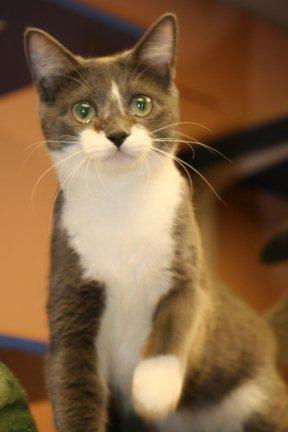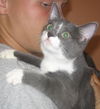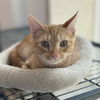Welcome to Pet Rescue By Judy!
401 South Laurel Avenue
Sanford, FL 32771
(407) 302-4497
info@petrescuebyjudy.com
Star the Kitten's Web Page

| My Rescue |
| Login to Remember your Favorite Animals and Breeds! |
Star the Kitten needs a caretaker or foster!
Won't you consider helping her get a new start?
Won't you consider helping her get a new start?
Name: Star the Kitten
Status: Adopted!
Adoption Fee: 75.00
Species: Cat
Breed: Domestic Short Hair (short coat)
Color: Gray and White
Sex: Female (spayed)
Current Size: 3 Pounds
Potential Size: 9 Pounds
General Potential Size: Medium
Current Age: 16 Years 1 Month (best estimate)
Activity Level: Highly Active
Indoor or Outdoor: Indoor Only
Good with Dogs: Yes
Good with Cats: Yes
Good with Kids: Yes
Declawed: No
Housetrained: Yes
Microchipped: Yes
Star the Kitten's sister, Darlene (adopted) can also be seen on our website.
Description:
Star and Darleen are the female half of the most popular set of kittens we've had here in a loooong time. Their brothers got fixed first and were adopted already. Of course, the entire volunteer staff was jealous and in tears when they got adopted because we all wanted them! Now the same is true of these two sweet, playful completely endearing little ladies. Hurry up and adopt them before one of Judy's volunteers runs off with them and you miss your chance!!!
03.21.10 Volunteer Update: Star was the hit of the kitty event today. She was playing with everyone and everything! Little girls loved playing with the kitty wand with her.
According to www.cat-lovers-only.com, cats have been domesticated for well over 3,000 years. House cat behavior patterns, however, are really not all that different from wild cats. In fact, the basic instincts and resulting patterns of activity and rest are basically the same as they were before domestication. Long before the Egyptians and African wild cats negotiated the original deal with each other of pest control for steady food and shelter, cats were hunting, stalking, and burying their feces in sandy substrate. Remember that what at first may be seen as bad cat behavior may have a reason behind it. Here's some insight that answers some questions on why your feline friend does certain things a certain way. The current behavior of today's house cats with respect to chasing mice, grabbing ankles, playing with toys, tearing into arms with back claws, and litter box behavior have their origins in those ancient felines. Stalking and hunting behaviors are deeply ingrained and cannot be trained out of your cat. As feline parents, we act as surrogate mothers for our cats, and we encourage kitten-like dependency and play behavior that lasts into adulthood. Underneath all that, however, our little bundles of fur are really just wild animals that have become our family members. A better understanding of cat behavior will allow you to provide better cat care for your little one. Understanding your cat's point of view and her special needs will help you to better enjoy your companion animal and treat your cat more the way she wants to be treated. This can help both of you to live a more enriched life. Embracing your cat's wild nature is essential. Part of that is to refrain from attempting to inflict a human measurement of punishment on your cat for things she can't control. You can't blame your cat for behaviors like the desire to hunt or attack, or for being choosy about the food she eats, or for not using a less than clean litter box. You can't blame her for going through the processes that lead to mating, including wanting to get out and meet other cats. What you can do, instead, is play to her instincts and needs in order to create a healthy and cat friendly environment. When you do so, you'll find that your furry companion will be much better behaved. It is highly suggested that you set up a cat sanctuary so that your cat has a safe and quiet place to rest and play. Domestic felines are extremely territorial and will defend their territory very much as they would if they lived in the wild. Cats are opportunists, and while they bond to their people and other animals they live with, they often will go wherever they find better food or amenities. Cats mark their territory with scent glands in various areas of the body, including the face, head, and tail. They may also urine spray to mark territory. Cat spraying behavior can become a real problem if it's happening inside the home. Stray cats may spray the outside of your house and create a defensive response in your cat, which ends up manifesting in the form of spraying indoors. There are a number of things you can do to stop spraying behavior, including reducing stress. Most indoor cats will agree to share territory and time share specific "favorite spots" with the other cats in the house. Disputes occur, but they're usually not major. Aggression between two or more cats in multi-cat households is often due to territorial disputes that go unresolved. A proper introduction in the first place can prevent a multitude of issues, but it will take some work and some refereeing on your part to resolve a cat behavior problem that has already developed. Aggressive cat behavior may also be a result of things going on that you don't see. For example, some cats in a household will fight with each other as a reaction to stray cats near the house outside. In the wild, the ancestors of the domestic cat lived a solitary life in northern Africa. They slept, hunted, and ate alone. They covered their tracks so as not to be preyed upon, and they behaved stealthy in order to hunt and catch their food (stalking is not for the loud or clumsy). Their very job is to remain undetected, and when challenged, to either fight off an attacker or escape into hiding. As such, they don't necessarily have a lot of signals to communicate what's going on in a number of social situations. Nevertheless, they are very sensitive creatures, and communicate in a number of ways including vocalizations, purring, and distinct body language. These aspects of cat behavior are extremely important, since this is how your cat tells you what she wants or doesn't want, whether or not she is content, and how you should treat her. Typically, if you talk to your cat, she'll talk back, at least at some point, with a variety of vocalizations. Of course, some cats rarely talk at all, and others talk much of the time. Some breeds, such as Siamese cats, are generally more talkative than others. Although there are exceptions, adult cats rarely meow at each other the way they meow at us. Meow, purr, roar, and other cat sounds are not only communication for cats, but a source of fascination for people. Certain cat breeds are known to exhibit certain behaviors. Of course, each cat is an individual (there's no denying that!), but there are some typical cat behavior patterns that apply to specific breeds. Siamese cats, for example, are known to be smart, very vocal, and very demanding of attention from their owners. Members of the Siamese breed are also known for their mischievous behavior. Ragdolls are known to be docile and friendly. The Maine coon cat is an excellent hunter, but has a gentle demeanor. Persians are known for being very loving. Turkish van's and Bengals are known for loving water. Some breeds are said to be more affectionate than others.
Other Pictures of Star the Kitten (click to see larger version):
 23.8k |
 42.4k |
 53.7k |
 61.5k |
 43.1k |
Copyright © Pet Rescue by Judy





